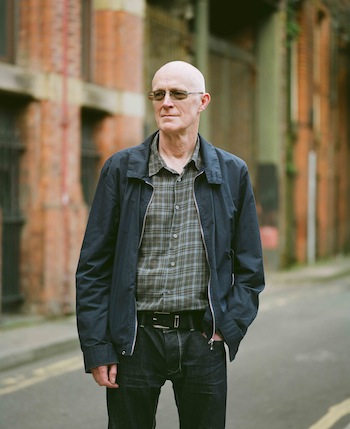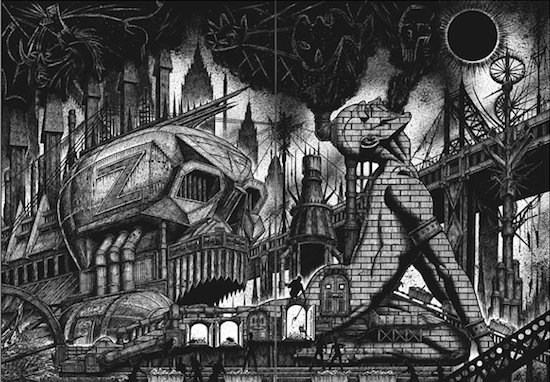The six-foot-two vegan writer, publisher and editor makes me another cup of strong black coffee in his flat in central Manchester overlooking the Hilton Tower. Sitting in the cluttered living room chatting, the sixty-five year old skinhead talks about several instances he’s known of people who have drowned in Mancunian canals over the years. His friend, who is smoking rollies in the background, laughs cynically and jokes, ‘Don’t hang around this guy. Your books won’t sell and you’ll end up in the river.’ This guy is Michael Butterworth, who has co-run indie publisher Savoy since 1976 with the enigmatic David Britton, whom Butterworth fondly refers to as ‘Devious’.
Savoy began as innovative paperback publishers, and in the Eighties and Nineties they moved on to include records and graphic works. As Butterworth offers up pieces of organic dark chocolate, it’s hard to imagine this generous man’s office and bookshops were raided by the Manchester Obscene Publications Squad more than sixty times, in a battle with the Manchester police that became known in Savoy mythology as the Savoy Wars. As political correctness took hold of the nation in the Eighties, it was a conflict that also encompassed attacks from the Left – from the alternative culture from which Savoy had grown. The company managed to piss off just about everyone. The story of Savoy is a tricky one, rife with judicial encounters and imprisonment. But, as always, there is another side to this coin – a softer side which often remains unsung.
Butterworth met Britton in Manchester in the early Seventies, and n 1996 told GQ: ‘Back in the Sixties, I was living on Ladbroke Grove and writing for New Worlds magazine.’ It was during this time that Butterworth befriended JG Ballard, who took Butterworth – as a young New Wave science fiction writer – under his wing. In a letter dated from 1967, Ballard gave Butterworth the sage advice to ‘never use more than one adjective per noun.’
In the early Seventies Butterworth moved back to Manchester with his family and worked in advertising for a brief spell. He continues, describing how he met Britton, ‘I was a freelance writer and novelist for a while. I edited New Vegetarian magazine and wrote sci-fi fantasy. At the same time Dave was running a bookshop, The House on the Borderland. We were both publishing small press fiction, fantasy and art magazines, and with my contacts and his money decided to get together to do something on a larger scale’.
Along with two other bookshops, The House on the Borderland was frequented by Joy Division’s Ian Curtis and Steven Morris in the late Seventies. Britton remembers Morris as an ‘Art Tripp and Michael Moorcock fan who had been expelled from school for some charming skulduggery’. Butterworth told Jon Savage a couple years ago that Curtis and Morris seemed to be ‘disparate, alienated young men attracted to like-minded souls. They wanted something offbeat and off the beaten track, and the shop supplied this. They probably saw it as a beacon in the rather bleak Manchester of the early 70s. They came in every couple of weeks, sometimes more often. Ian bought second-hand copies of New Worlds, the great 60s literary magazine edited by Michael Moorcock, which was promoting Burroughs and Ballard.’ Curtis and Butterworth went on to become friends around 1979 and Curtis often visited Butterworth’s lodger’s house in Altrincham.

(Photograph by Stephen Iles
Butterworth remembers, ‘I got to know Ian because of his interest in William Burroughs. I gave him books we’d done, and he invited me to Joy Division gigs. He was a clerk at the DHSS, and quite reserved, but by night he was a bizarre performer with weird, half-reluctant jerky movements. Watching him sing could actually be painful… Just as our friendship was building and Joy Division were on the eve of touring America, of course, Ian killed himself.’
After Curtis’s death, Savoy’s Butterworth and Britton teamed up with PJ Proby in the early Eighties to record or ‘massacre’ – in Britton’s words – some of Joy Division’s tracks including ‘Love Will Tear Us Apart’. In spite of his humility, however, Melody Maker described the cover as ‘the complete portrait of sexual paranoia. Proby’s [version] is a full-blown Hitchcock masterpiece.’ Of the decision to commission Proby for recordings, including a reading of Lord Horror, Britton recalled: ‘It is the correct Savoy perversity to put PJ Proby in the aural landscape as we did, to try and capture that malignant spark that Good and Cohn had seen in him. He was never a Scott Walker, a Tom Jones or a Robbie Williams, he was being fashioned in a more apocalyptic stew. For us he was definitely the right man in the right place at the right time, and if anyone doesn’t believe that – go and listen to the records.’
But Savoy wasn’t all music and books. The same year that Savoy was founded, James Anderton became Chief Constable of the Greater Manchester Police. Savoy describes his reign as creating a continuous criticism of their work and that Anderton and his men were ‘locked in a seeming conspiracy’ against them. After countless raids into Savoy’s bookshops and offices, seizing hundreds of thousands of pounds worth of materials, Savoy Books was forced into temporary liquidation in 1981. They lost publishing copyrights and so became book packagers to survive the blow.
The Manchester Police continued to raid Savoy after Britton and Butterworth had begun producing their own works in order to regain copyrights, commencing with the insurgent novel Lord Horror – the works that have led American anthologists Jeff and Ann VanderMeer to hail them as precursors of the New Weird. After Lord Horror was published in 1989, the graphic title got seized by the police. Police raids continued until 1997 and some Savoy titles were seized by UK Customs in 1999.
In May of 1982, Britton was dealt a twenty-eight day sentence imposed by Manchester Judge James Hardy as result of a police raid in 1980. Britton recalls, ‘Strangeways Prison, then, in 1982, was a truly terrible place, the equal in terror and intimidation of a prison in a corrupt third world country. When people are being burned alive in cells opposite, you get some hint of what Auschwitz must have been like. Prison didn’t cure me. It just made me more bitter, and more determined to retaliate.’
The illustrator of Lord Horror, John Coulthart, recalled of the early raids, ‘The police seemed especially concerned with the German slogans I put into the pictures [of Lord Horror], so much so that they had them translated – foreign languages not being a speciality of the Greater Manchester Police. We were never given any explanation for this. The unstated implication seemed to be that we were trying to plant Nazi propaganda into young minds. The irony – as if there wasn’t enough already – was that the slogans were place there as a critique of the usual propaganda.’
Savoy has announced the early 2013 publication of the eighth and culminating graphic title in the Lord Horror series, Reverbstorm. The comic began life as a Lord Horror film treatment Butterworth and Britton did for Harvey Weinstein, but quickly took on a life of its own in the freewheeling Savoy hothouse. Its title derives from a Northern Soul track and the novel itself abounds with references to pop culture, including Captain Beefheart. The Lord Horror graphic series attempts to deconstruct Western literature and philosophy, quoting from TS Eliot and James Joyce as well as referencing canonical artists like Georges Seurat. In characteristic Lord Horror picaresque style, the creative team behind the book including author Britton, editor Butterworth and artist John Coulthart often use a slapstick approach to taboo subjects such as Hitler and Auschwitz.
Coulthart explains, ‘The creation of Reverbstorm took the path of most of Savoy’s original works whereby a number of key ingredients were laid down as a starting pint from with the work “jess grew”, to borrow a phrase of Ishmael Reed’s. Needless to say, most comic artists who are used to working from very tight scripts would find this situation impossible to cope with. Improvisation is a common thing in music, of course, and novels are frequently written without much sense of how they might develop. Yet for some reason comics, by which I mean English-language comics, show a deep resistance to these methods, the implication being that it’s far better to plot everything out with a hackneyed storyline than just jump in and see where the thing goes… With Reverbstorm this format of presenting eight issues had the advantage of giving a structure to a narrative that might otherwise have been somewhat uneven.’
Continuing to discuss his sources for Reverbstorm, he explains, ‘The ingredients, then were largely hangovers from the film treatment: Horror, Jessie and James Joyce in a New York-like city, themes and references from the “Reverbstorm” song lyrics (Ether Jumpers), Blue Blaze Laudanum, the “Souls”, and some (initially) token art reference concerning the Seurat pictures and their relation to Sondheim’s Sunday in the Park with George. Dave gave me some of Burne Hogarth’s Tarzan books to look at for atmosphere and character presentation; I then suggested that we should have apes in the city (thinking of King Kong and all the other rampaging urban apes in films of the Thirties.) Picasso crept in pretty quickly after that, and finally we ended up with Hogarth’s Ononoes in the mix as well. These appear in Lord Horror, but this was the first time they’d featured in a comic since Hogarth had created them in the late Forties…. Three visual leitmotifs are established for the three main characters: Picasso for Horror, Seurat for Jessie and Finnegans Wake for Joyce (with text ripped from the book and stuck on the pages).’
Of Savoy’s success, Britton says, ‘We never actually made money out of Savoy – and still don’t. Not one book returns its financial investment.’ Britton remembers how in the early days the Savoy offices got sent Kathy Acker’s Blood and Guts in Highschool, which they rejected and now consider a mistake. Savoy describes itself as ‘England’s truly alternative and autotelic publishing company’. And perhaps it is.
The defiantly Northern English publishers couldn’t care less about being on trend or of the moment. Opting for indifference and black humour, Savoy celebrates anarchy, its punk heritage and a penchant for the uncanny.
Reverbstorm will be available in February 2013
Follow @theQuietusBooks on Twitter for more


